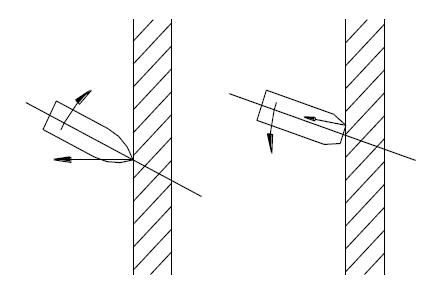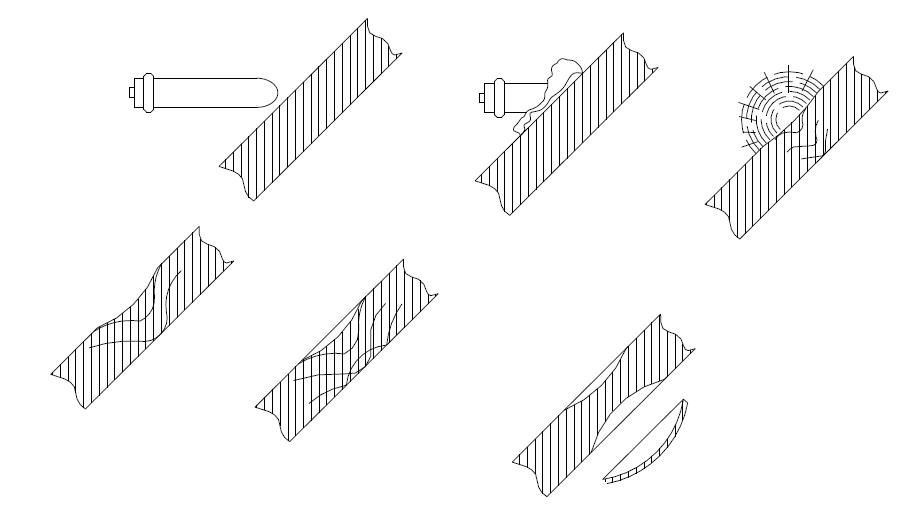弹头反着装能提高侵彻力????
来源:百度文库 编辑:超级军网 时间:2024/04/28 01:20:00
一本资料上说,一战初期,没有专门的穿甲弹。德军狙击手发现,如果子弹弹头拔出来,再掉个头装回去,威力将会大很多,基本上可以穿透当时的防弹钢板。
书上说这就是“空心装药穿甲弹”的前身…………
我想,弹头里面又没炸药…………怎么来的“聚能效应”…………
但是,能提高侵彻力可能是真的,只不过,没说对原因。
一本资料上说,一战初期,没有专门的穿甲弹。德军狙击手发现,如果子弹弹头拔出来,再掉个头装回去,威力将会大很多,基本上可以穿透当时的防弹钢板。
书上说这就是“空心装药穿甲弹”的前身…………
我想,弹头里面又没炸药…………怎么来的“聚能效应”…………
但是,能提高侵彻力可能是真的,只不过,没说对原因。
这是什么书啊~~~~
曲奇 发表于 2009-9-27 02:20 
环球时报?

环球时报?
不怕炸膛?:o
我也看的十分之迷茫…………
这怎么进膛线啊?
不相信。个人意见如下:
1。如果弹头是反着飞出去的,在空气阻力作用下也会翻过来,然后翻着跟头往前飞。此时如果集中软目标,杀伤里可能更大,因为子弹可能是横着进去的。但是如果子弹横着打到装甲上,肯定效果更差。
2。没有什么理由可以增加穿甲能力。什么空心装药之类跟这个没有关系。
3。如果这么做真管用,全世界的穿甲弹早就做成这个样子了。
1。如果弹头是反着飞出去的,在空气阻力作用下也会翻过来,然后翻着跟头往前飞。此时如果集中软目标,杀伤里可能更大,因为子弹可能是横着进去的。但是如果子弹横着打到装甲上,肯定效果更差。
2。没有什么理由可以增加穿甲能力。什么空心装药之类跟这个没有关系。
3。如果这么做真管用,全世界的穿甲弹早就做成这个样子了。
云里雾里- -!
caesar1223 发表于 2009-9-27 01:53 
最近看的资料挺杂呀~~~:L

最近看的资料挺杂呀~~~:L
alex182 发表于 2009-9-28 02:09 
其实,是同一本书……………………

其实,是同一本书……………………
这是胡说八道!!!!
很好奇为什么不炸糖
“空心装药穿甲弹”才是亮点啊诸君

楼上想当然的诸位,看明白了吗?
弱弱的问一下,反装弹头后子弹的弹道不会变得不稳定吗
又不是让你在300米距离上“狙击”坦克,一战时用步枪打坦克100米甚至是几十米距离内,目标又那么大,你还担心打不中么?
但兰州说的是狙击手啊,一战时的狙击手也不会跑到最前面吧
不过要是一般步兵就还说得过去
不过要是一般步兵就还说得过去
jū jī ㄐㄨ ㄐㄧ
狙击(狙擊)
◎ 狙击 jūjī
[snipe] 埋伏在隐蔽处伺机袭击
你就是躲巷子角抡折凳偷袭那也是狙击……
狙击(狙擊)
◎ 狙击 jūjī
[snipe] 埋伏在隐蔽处伺机袭击
你就是躲巷子角抡折凳偷袭那也是狙击……
那应该是冷兵器时代的定义吧......
况且有哪个狙击手蛋疼到去打坦克,个人还是觉得是资料错了,应该是一般步兵才对
况且有哪个狙击手蛋疼到去打坦克,个人还是觉得是资料错了,应该是一般步兵才对
彈頭的最佳氣動外型,是橄欖核狀........
為了要最大可能地承受火藥的作用力,才造成船型與凹陷彈底........
如果倒著裝箝彈頭能增大侵徹力--應該最大的原因是動能--那何必要在戰場自己動手,通通這樣出廠不是更省力嗎......
為了要最大可能地承受火藥的作用力,才造成船型與凹陷彈底........
如果倒著裝箝彈頭能增大侵徹力--應該最大的原因是動能--那何必要在戰場自己動手,通通這樣出廠不是更省力嗎......
那些反坦克炮彈頭也不用造成箭簇啦.........裝個前掠翼算了.
duketassadar 发表于 2009-9-28 11:40 
这才叫想当然。

这才叫想当然。
山人256 发表于 2009-9-28 13:50 
我确实是想当然地高估了大部分CD人的参悟能力,那么再看看这个总能明白了吧?


我确实是想当然地高估了大部分CD人的参悟能力,那么再看看这个总能明白了吧?

楼上给的是碎甲弹。
23# duketassadar
大能啊!子弹掉个头就能当碎甲蛋用啊{:3_81:}
大能啊!子弹掉个头就能当碎甲蛋用啊{:3_81:}
想想钝头穿甲弹和碎甲弹的原理。
另外再想想当时坦克的装甲厚度和材料。
另外再想想当时坦克的装甲厚度和材料。
睡眼惺忪 发表于 2009-9-28 19:19 
你大锤抡得够快的话,一样可以当碎甲弹用。

你大锤抡得够快的话,一样可以当碎甲弹用。
duketassadar 发表于 2009-9-28 19:29 
兄弟,碎甲弹的原理是拉伸波崩落原理。。。。。。
钝头穿甲弹可不是这个原理。

兄弟,碎甲弹的原理是拉伸波崩落原理。。。。。。
钝头穿甲弹可不是这个原理。
duketassadar 发表于 2009-9-28 19:29 
兄弟谁告诉你碎甲弹必须得应力波阵面平整的?

兄弟谁告诉你碎甲弹必须得应力波阵面平整的?
如果正装不能击穿而反装能击穿,那就是钝头穿甲弹。
如果反装也不能击穿,但是却给里面的乘员造成了杀伤,那就是崩落效应。
如果反装也不能击穿,但是却给里面的乘员造成了杀伤,那就是崩落效应。
盗版书,作不的真的。
书未必就有,很可能是某处找来的网文而已。只不过这篇文章的译者是个一知半解的半吊子,文章中一些自己没弄明白的东西就用想当然的理解去掩饰。那个“空心装药穿甲弹”,译者肯定是把"spray of metal"(金属飞沫)给当成了"jet of metal"(金属射流),所以才有了“空心装药穿甲弹”云云。
其实一战时坦克的装甲很薄,Mark Ⅰ才只有6-12mm厚的钢板,比现在常用钢轨工字钢中间最薄的那段还要薄。以一战时期德国步枪的威力是可以在较近距离上击穿的,但是战场上往往不能以最佳的入射角来射击,打上去的子弹会形成跳弹碎裂而难以发挥威力。
采用“逆装弹”的方式安装弹头,实际上相当于是制作了一枚“钝头穿甲弹”。其实还有一点是楼主没有提及的,那就是这种“逆装弹”多半都是要做强装药的,这样可以赋予弹丸更高的动能。但是动能并不是决定穿甲能力的唯一因素,“逆装弹”在碰击装甲时,是弹丸尾部先触及装甲。这部分的接触面积大,形成了钝头部,使得弹丸不易破碎;钝头部改善了着靶时的受力状态,在一定程度上可防止跳弹(如14#图);钝头部便于破坏钢甲表面,易产生剪切冲塞破坏,其穿甲能力反而高于尖头弹。这就是逆装弹侵彻力比普通弹高的原因。
但是事情并不仅止于此,实际上逆装弹击穿装甲的情况并不在实战中占到较多的比例,更多的情况是并未击穿装甲,但是却还是对车内的乘员造成了杀伤。这是因为逆装弹的外形使得它能更有效得向目标传递动能,即便是在没有击穿的情况下,却也能令当时较薄的装甲钢板产生和碎甲弹同原理的崩落效应,在装甲内侧形成高速金属飞沫(碎片细小,所以只能形容为“沫”)对车内乘员造成了杀伤。英国人当时的实验结果表明,要完全阻止“逆装弹”在近距离射击所产生的崩落效应,需要将镍铬合金材质的装甲钢板的厚度加大到0.5英寸(12.7mm)才行。
书未必就有,很可能是某处找来的网文而已。只不过这篇文章的译者是个一知半解的半吊子,文章中一些自己没弄明白的东西就用想当然的理解去掩饰。那个“空心装药穿甲弹”,译者肯定是把"spray of metal"(金属飞沫)给当成了"jet of metal"(金属射流),所以才有了“空心装药穿甲弹”云云。
其实一战时坦克的装甲很薄,Mark Ⅰ才只有6-12mm厚的钢板,比现在常用钢轨工字钢中间最薄的那段还要薄。以一战时期德国步枪的威力是可以在较近距离上击穿的,但是战场上往往不能以最佳的入射角来射击,打上去的子弹会形成跳弹碎裂而难以发挥威力。
采用“逆装弹”的方式安装弹头,实际上相当于是制作了一枚“钝头穿甲弹”。其实还有一点是楼主没有提及的,那就是这种“逆装弹”多半都是要做强装药的,这样可以赋予弹丸更高的动能。但是动能并不是决定穿甲能力的唯一因素,“逆装弹”在碰击装甲时,是弹丸尾部先触及装甲。这部分的接触面积大,形成了钝头部,使得弹丸不易破碎;钝头部改善了着靶时的受力状态,在一定程度上可防止跳弹(如14#图);钝头部便于破坏钢甲表面,易产生剪切冲塞破坏,其穿甲能力反而高于尖头弹。这就是逆装弹侵彻力比普通弹高的原因。
但是事情并不仅止于此,实际上逆装弹击穿装甲的情况并不在实战中占到较多的比例,更多的情况是并未击穿装甲,但是却还是对车内的乘员造成了杀伤。这是因为逆装弹的外形使得它能更有效得向目标传递动能,即便是在没有击穿的情况下,却也能令当时较薄的装甲钢板产生和碎甲弹同原理的崩落效应,在装甲内侧形成高速金属飞沫(碎片细小,所以只能形容为“沫”)对车内乘员造成了杀伤。英国人当时的实验结果表明,要完全阻止“逆装弹”在近距离射击所产生的崩落效应,需要将镍铬合金材质的装甲钢板的厚度加大到0.5英寸(12.7mm)才行。
32# duketassadar
咋听着这么玄乎呢,出处是哪里?
咋听着这么玄乎呢,出处是哪里?
duketassadar 发表于 2009-9-29 02:18 
继续追问此文出处...

继续追问此文出处...
topwa 发表于 2009-9-29 11:55 
http://www.1911encyclopedia.org/Armour_Plate
...The ordinary service bullet, consisting of a cupro-nickel (or in some cases a mild steel) case filled with lead, breaks up fairly easily on a plate of hard steel; but the Germans soon discovered that if the bullet is removed from the cartridge and reversed (i.e. so that the bullet travels with the base or blunt end in front instead of the pointed end) it did not break up but punched a hole in the plate.
Every effort was made to defeat this attack, but it was found that even with the use of the best quality of alloy steel available a minimum thickness of half an inch was necessary to stop the reversed bullet at short range. All sorts of materials were employed, but steels were found to be the most efficient, and of these nickel, chrome, manganese, vanadium, molybdenum and zirconium, both singly and in combination, were all tried. The best results, however, were obtained from nickel-chrome plates, sometimes with an addition of one of the rarer metals.
While these experiments were being carried out in England the Germans were busy endeavouring to produce something more satisfactory than the reversed bullet which was only effective at short range. In this they were completely successful, and they produced the K or armour-piercing bullet. This consists of an outer envelope of mild steel of the same size and dimensions as the ordinary bullet. In the centre of the envelope is the bullet proper, made of hardened tungsten steel 30 mm. long, 6 mm. in diameter, and pointed at one end. The space between the envelope and the hard bullet is filled with lead. On striking a hard steel plate the outer envelope breaks up, but it and the lead lining appear to perform the function of a cap, and the hardened steel bullet perforates the plate.
At ranges up to 60 yd. with a good rifle, and more than this with a rifle in which the rifling has been worn, the armour-piercing bullet is not effective, owing to unsteadiness in flight, but at longer ranges nothing less than half an inch of the best steel is of any use as a protection against a direct hit at the normal. The action of the armour-piercing bullet, however, differs from that of the reversed bullet. The former is a clean penetration of the plate, whereas the latter punches a hole and removes a portion of the plate in the form of a small cylinder. Both at long and short ranges, therefore, a plate of at least half an inch in thickness was found to be necessary to give any real protection, and as plates of this thickness weigh 20 lb. per sq. ft. it was obvious that a soldier could not carry his own means of protection in addition to a rifle and the other impedimenta which he took into action. It became necessary then to devise some mechanical method of carrying protection, and the combined efforts of many minds in this direction finally resulted in that weapon of offence and defence which was afterwards known as a "tank".

http://www.1911encyclopedia.org/Armour_Plate
...The ordinary service bullet, consisting of a cupro-nickel (or in some cases a mild steel) case filled with lead, breaks up fairly easily on a plate of hard steel; but the Germans soon discovered that if the bullet is removed from the cartridge and reversed (i.e. so that the bullet travels with the base or blunt end in front instead of the pointed end) it did not break up but punched a hole in the plate.
Every effort was made to defeat this attack, but it was found that even with the use of the best quality of alloy steel available a minimum thickness of half an inch was necessary to stop the reversed bullet at short range. All sorts of materials were employed, but steels were found to be the most efficient, and of these nickel, chrome, manganese, vanadium, molybdenum and zirconium, both singly and in combination, were all tried. The best results, however, were obtained from nickel-chrome plates, sometimes with an addition of one of the rarer metals.
While these experiments were being carried out in England the Germans were busy endeavouring to produce something more satisfactory than the reversed bullet which was only effective at short range. In this they were completely successful, and they produced the K or armour-piercing bullet. This consists of an outer envelope of mild steel of the same size and dimensions as the ordinary bullet. In the centre of the envelope is the bullet proper, made of hardened tungsten steel 30 mm. long, 6 mm. in diameter, and pointed at one end. The space between the envelope and the hard bullet is filled with lead. On striking a hard steel plate the outer envelope breaks up, but it and the lead lining appear to perform the function of a cap, and the hardened steel bullet perforates the plate.
At ranges up to 60 yd. with a good rifle, and more than this with a rifle in which the rifling has been worn, the armour-piercing bullet is not effective, owing to unsteadiness in flight, but at longer ranges nothing less than half an inch of the best steel is of any use as a protection against a direct hit at the normal. The action of the armour-piercing bullet, however, differs from that of the reversed bullet. The former is a clean penetration of the plate, whereas the latter punches a hole and removes a portion of the plate in the form of a small cylinder. Both at long and short ranges, therefore, a plate of at least half an inch in thickness was found to be necessary to give any real protection, and as plates of this thickness weigh 20 lb. per sq. ft. it was obvious that a soldier could not carry his own means of protection in addition to a rifle and the other impedimenta which he took into action. It became necessary then to devise some mechanical method of carrying protection, and the combined efforts of many minds in this direction finally resulted in that weapon of offence and defence which was afterwards known as a "tank".
36# duketassadar
我靠…………这么大段的英文,我看见就头疼了………………
我靠…………这么大段的英文,我看见就头疼了………………
duketassadar 发表于 2009-9-28 19:58 
无论什么穿,都能在均质装甲的背面产生崩落。
反装弹道能稳定才怪了呢

无论什么穿,都能在均质装甲的背面产生崩落。
反装弹道能稳定才怪了呢
caesar1223 发表于 2009-9-29 12:29 
别自卑,其实都一样,哪国都有不靠谱的读物~~~:D

别自卑,其实都一样,哪国都有不靠谱的读物~~~:D
在装甲内侧形成高速金属飞沫(碎片细小,所以只能形容为“沫”)对车内乘员造成了杀伤。
============================================================
比如这一句就是个重大错误
形成的是金属飞沫?真搞笑,那作者看来以为弹径越小,生成细小碎片的比例就越大。明显是没有相关知识在那想当然的杰作
============================================================
比如这一句就是个重大错误
形成的是金属飞沫?真搞笑,那作者看来以为弹径越小,生成细小碎片的比例就越大。明显是没有相关知识在那想当然的杰作